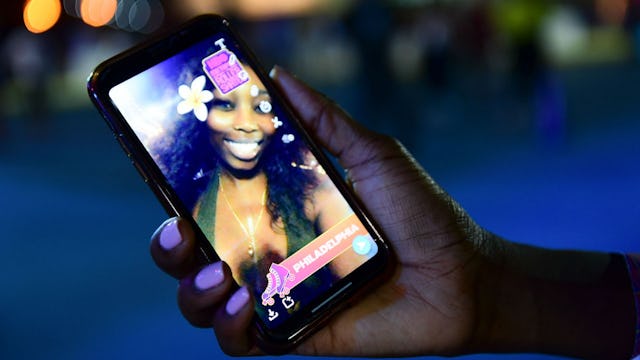People Are Getting Plastic Surgery To Look Like Their Filtered Selfies

I’ll bet women of the ’50s (or even the ’80s) never fathomed their kids and grandkids growing up in a world of selfies and filters and addiction to plastic surgery to look like said filters.
Yet, thanks to social media, here we are.
Whether we want to admit it or not, social media dysmorphia is taking hold of today’s young people (and even some older people as well). According to an article from The Chicago Tribune, this obsession with changing our faces to look like unrealistic filters is “causing widespread concern among experts who are worried about its negative effect on people’s self-esteem.” And, as the article adds, this trend has the “potential to trigger body dysmorphic disorder, a mental illness classified on the obsessive-compulsive spectrum.”
People! We’re talking about social media and apps that add dog noses and cat ears to your face. It’s supposed to be for fun. Sure, there are filters that can also blur out the crows feet around my eyes and dark circles under my eyes. But when you see my semi-blurred face with impeccable complexion (and also BUNNY EARS), that isn’t what I actually look like.
Unfortunately, the line between reality and this unattainable ideal is also blurred in people’s minds. And they are literally having their faces surgically altered as a result.
Obviously people’s tendency to obsess over their looks isn’t a new concept. Women were trying desperately to achieve Marilyn Monroe’s sex appeal 60 years ago. But because of filters and editing apps throughout social media, most of the images people now put forth for the world to see aren’t a true representation of their appearance. Yet, we all compare ourselves to these false faces anyway.
In the Chicago Tribune article, Northwestern University psychology professor Renee Engeln says that “our sense of what’s real, what’s possible when it comes to beauty, is warped by our overexposure to these images. Instead of seeing them for what they are, which is extraordinarily rare, we start to see them as typical or average.”
We’ve grown to expect filters and editing of images, meaning the new “beauty standard” includes touch-ups. So I guess that makes the 100% non-edited pics I upload unattractive? Even though that’s what I actually look like? Well, shit.
Tijion Esho, a British cosmetic surgeon, says that “Today’s generation can’t escape ‘the Truman effect’ because from birth they are born into an age of social platforms where their feelings of self-worth can be based purely on the number of likes and followers that they have, which is linked to how good they look or how great these images are.”
And unfortunately he’s right. What used to be an obsession with looks in generations before us has today manifested into an obsession with plastic surgery with life-long consequences. Today’s selfie culture is spending billions of dollars to surgically enhance their features for one reason—to look better for social media. Surgical procedures that previously were reserved for movie stars have now become mainstream for “regular” people who merely want to look better on social media. And the numbers grow every year.
“In 2017, the survey found that 55 percent of surgeons reported seeing patients who requested surgery to look better in selfies — a 13 percent increase from the previous year’s results,” the article states.
And since it’s getting easier and easier to change our faces in pictures, we are expecting these results in real life now too.
But the truth is, this is a losing battle. No one actually looks like these filters in real life—not even Kim Kardashian or Beyonce. And sadly, what we are left with is a changed face and a feeling of emptiness as we chase an unrealistic dream.
Listen, I’m facing the ugly truth of aging along with the rest of you. The occasional gray hair, the extra wrinkle in my forehead, the sagging boobs and jiggly stomach—I’m in the same boat. I’ve fallen prey to lotions and creams and age-defying makeup just like any other woman who catches a glimpse of herself as she nears 40 and gasps in horror.
But we all age. We all get the occasional pimple or extra freckle we hate. It’s up to us to find that line between trying out a new age-spot remover or dying our roots and paying a doctor to cut open our faces so we look like the 28th filter we found while swiping on our phones.
This article was originally published on